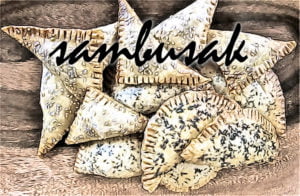One can have hot or cold samosa, which is an anytime snack. It can be filled with spicy keema or vegetarian versions filled with potatoes, paneer or even peas and French beans.
The French call them ‘pastillas’, but to entice the Asians, they put samosa on the menu. In Montreal, the restaurants hardly know what a samosa is, but it’s there on the menu without any explanation.
Somewhat less surprisingly, the samosa has also been welcomed into the British mainstream. It frequently turns up in up-market picnic hampers sold by Harrods, Fortnum and Mason.
This makes the Middle Easterners very angry: Samosa is not really an Indian dish at all.
Even Indian food writers concede that the earliest mentions of the samosa in Indian literature can only be found after the Muslims established their kingdoms in India. Samosas turn up again and again on Mughal menus, usually as savories stuffed with various kinds of keema. Even today, a version of the samosa — called ‘sambusak’ — is eaten all across the Middle East.

According to Alan Davidson’s ‘Penguin Companion to Food’, the very name samosa comes from the Persian word ‘sambosag’. By the 10th Century, Arab cookbooks were already giving the recipe and called it ‘sambusak’.
The samosa/sambusak spread all across the Middle East as conquerors and traders travelled and it took various forms and myriad shapes in each country. The original sambusak was probably a half-moon but as it moved, it acquired its current triangular shape.
So what was India’s contribution? How did we turn the sambusak into the samosa?
It is almost certain that Indians were not into baking until the Muslims got here. Nor were we very familiar with refined flour or maida. We used atta which, though healthier, was somewhat more limited when it came to the possibilities for pastry.
The original sambusak was probably made from maida. It might well have also been baked. In that sense it was related to the pastilla of Morocco and Spain and the pastele of the Sephardic Jews. Other European pastry dishes such as the puff and the pasty probably derived from the same source.
Fried, Not Baked
But an army cannot bake. Nor can a wandering trader. Somewhere along the way, the people of the Middle East began frying their sambusaks. It is easy to see why they would do this: you can fill a dekchi with oil and build a fire pretty much anywhere you go. An oven is much more difficult to construct. So, by the time traders and conquerors had made the journey to India from Europe and Central Asia, they had given up on the baked version. The sambusak they brought to India was probably fried.
Genius Of Indian Cooking
Then, the genius of Indian cooking took over. India has a long tradition of taking so-so Middle Eastern foods (the pulao or the kebab, for instance) and turning them into delicacies. At the Mughal court, the sambusaks or samosas were not filled with pumpkins and walnuts as they had been in the Middle East. Instead, Indian cooks devised delicate and more innovative fillings.
It is said that the Mughal chefs loved keema because it was the perfect medium for transferring any kind of flavour. So, court chefs took the boring sambusak and turned it into an haute cuisine dish.
Halwai Tradition
My take and only logical understanding is that Indian cooks: non-court cooks and Hindu halwais took the sambusak/samosa and married it to another Indian tradition — the deep fried snack such as the pakora, vada, the bonda or the kachori.
When the samosa moved out of the court kitchens and into the streets, it was quickly turned into that kind of halwai snack. It ceased to be the sort of haute cuisine dish that had to be eaten as soon as it was made. The distinguishing feature of the samosa these days is that it is often served several hours after it has been cooked.
As deep fried foods do not keep very well, cooks have had to make compromises. Vegetarian fillings are not just cheaper but they are also less likely to go off. A thin and delicate batter will get soggy quickly so fat Punjabi-style shells have been used to encase the filling. And because even these do not stay crisp for very long, halwais have invented samosa chaat in which the samosa is broken up and then doused with chutney (and sometimes, dahi) so that the texture of the casing does not matter so much.
One has nothing against halwai samosas or their regional variations singada of Odisha but the best samosas are still the small, crisp ones with a thin casing that are served soon after they are made.
Rediscovering Samosa
The non-vegetarian version is associated with Gujarati Muslim communities (the Bohras, the Khojas, and the Memons etc.) and there is a delicate vegetarian version (with such fillings as French beans and peas) that most traditional maharajas (marwari cooks) will make.
The fat Punjabi samosa has taken over just as the fat Punjabi chef has, at most hotels and restaurants. Now, all we need is for the great Indian cooks – to rediscover the samosa and to treat it with the respect it deserves.
There is a lost tradition waiting to be revived here.
14 Different Variants Of Samosa You Must Try At Least Once
- Chole Samosa
- Chowmein Samosa
- Pasta Samosa
- Keema Samosa
- Cheese Samosa
- Chocolate Samosa
- Khoya Samosa
- Fried Rice Samosa
- Matar Soya bean Samosa
- Pastry Samosa
- Egg Samosa
- Paneer Samosa
- Jam Samosa
- Fish Samosa


